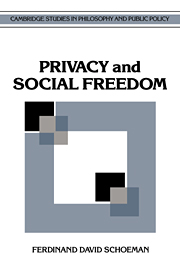Book contents
- Frontmatter
- Contents
- Acknowledgments
- Introduction
- 1 The meaning and scope of privacy
- 2 Mill's approach to social freedom
- 3 Articulated rationality and the Archimedean critique of culture
- 4 Social freedom from the perspective of cognitive and social psychology
- 5 The importance of cultural authority for morality
- 6 Explaining privacy's place
- 7 The ascent of privacy: a historical and conceptual account
- 8 Privacy and gossip
- 9 Privacy and spheres of life
- 10 Spheres of life: a literary exploration
- Epilogue
- Notes
- Index
10 - Spheres of life: a literary exploration
Published online by Cambridge University Press: 23 October 2009
- Frontmatter
- Contents
- Acknowledgments
- Introduction
- 1 The meaning and scope of privacy
- 2 Mill's approach to social freedom
- 3 Articulated rationality and the Archimedean critique of culture
- 4 Social freedom from the perspective of cognitive and social psychology
- 5 The importance of cultural authority for morality
- 6 Explaining privacy's place
- 7 The ascent of privacy: a historical and conceptual account
- 8 Privacy and gossip
- 9 Privacy and spheres of life
- 10 Spheres of life: a literary exploration
- Epilogue
- Notes
- Index
Summary
In Chapters 6 and 7, I discussed the social dynamics of the boundaries between various associative and functional ties. We saw there that the degree of transparency of these boundaries both influenced and was influenced by the degree of social control present or deemed desirable. The more it is thought that people within one domain of life ought to be free from social control by those not associated within the domain, the more opaque the boundaries. The more people regard some activity within a domain as important to control at all costs, or the more people realize that pressures from within a domain are inadequate to achieve important social objectives, the more transparent the boundaries. Activity within a domain I labeled a ‘sphere of life.’ I developed the relationship between social freedom and privacy, interpreting privacy norms as limiting access, both observational and regulative, to a person. This limited access was characterized as a many-place relationship: It is relative to given people, in a given situation, within a given domain, and to a given capacity.
In the preceding chapter, I argued that analysis of social life in terms of this depiction of privacy affords us a better tool for understanding our privacy practices than does the standard public–private distinction. Privacy limits access to people not only in their private lives but in nearly all the domains of their lives. If we think of a spectrum of domains, it is not only those characterized as part of private life that are governed by privacy norms.
- Type
- Chapter
- Information
- Privacy and Social Freedom , pp. 165 - 191Publisher: Cambridge University PressPrint publication year: 1992



